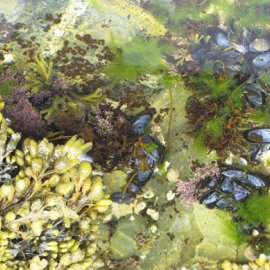The Marginal World: Readings from Rachel Carson's "The Edge of the Sea"
-
English
-
ListenPause
Welcome to World Ocean Radio… I’m Peter Neill, Director of the World Ocean Observatory. It is summer here in the United States, in Maine, long summer days and cool evenings. We are inundated by visitors -- so many others who come to share with those of us who live here year-round the coastal marsh, granite shore, and relentless ocean. We must be grateful for this place, and all such ocean places worldwide, and we should dedicate ourselves to their certainty in a time off uncertainty, to their beauty when ugliness intrudes, to their continuing conservation and access when some would take or destroy. As an advocate for the ocean, it is always important for me to put such work in context, to address the reasons why. If summer gives us then a moment for reflection, for affirmation, for re-commitment, then one can do no better than to turn for insight to the great American naturalist and author, Rachael Carson, to these selected excerpts quoted from her The Edge of the Sea, first published in 1956. She writes: “The edge of the sea is a strange and beautiful place. All through the long history of Earth it has been an area of unrest where waves have broken heavily against the land, where the tides have pressed forward over the continent, receded, and then returned. For no two successive days is the shoreline precisely the same. Not only to the tides advance and retreat in their eternal rhythms, but the level of the sea itself is never at rest. It rises or falls as the glaciers melt or grow, as the floor of the deep ocean basins shift under is increasing load of sediments, or as the earth’s crust along the continental margins warps up or down in adjustment to strain and tension. Today a little more land may belong to the sea, tomorrow a little less. Always the edge of the sea remains an elusive and indefinable boundary. “Looking out over the cove I felt a strong sense of the interchangeability of land and sea in this marginal world of the shore, and of the links between the life of the two. There was also an awareness of the past and of the continuing flow of time, obliterating much that had gone before…” “ The sequence and meaning of the drift of time were quietly summarized in the existence of hundreds of small snails – the mangrove periwinkles – browsing on the branches and roots of trees. Once their ancestors had been sea dwellers, bound to the salt waters by every tie of their life processes. Little by little over the thousands and millions of years the ties had been broken, the snails adjusted themselves to life out of water, and now today they were living many feet above the tide to which they only occasionally returned. And perhaps, who could say how many ages hence, there would be in their descendants not even this gesture of remembrance for the sea. “The spiral shells of other snails – these quite minute – left winding tracks on the mud as they moved about in search of food. They were horn shells, and when I saw them I had a nostalgic moment when I wished I might see what Audubon saw, a century and more ago. For such little horn shells were the food of the flamingo, once so numerous on this coast, and when I half closed my eyes I could almost imagine a flock of these magnificent flame birds feeding at that cove, filling it with their color. It was mere yesterday in the life the earth that they were there in nature, time and space are relative matters, perhaps most truly perceived subjectively in occasional flashes of insight, sparked by such a magical hour and place. “There is a common thread that links these scenes and memories – the spectacle of life in all its varied manifestations as it has appeared, evolved, and sometimes died out. Underlying the beauty of the spectacle there is meaning and significance. It is the elusiveness of that meaning that haunts us, that sends us again and again into the natural world where the key to the riddle is hidden. It sends us back to the edge of the sea, where the drama of life played its first scene on earth and perhaps even in its prelude; where the forces of evolution are at work today, as they have been since the appearance of what we know as life; and where the spectacle of living creatures faced by the cosmic realities of their world Is crystal clear.” We will discuss these issues, and more, in future editions of World Ocean Radio. WORLD OCEAN RADIO IS A PROJECT OF THE WORLD OCEAN OBSERVATORY, IN ASSOCIATION WITH WERU-FM, BLUE HILL, MAINE. FIND OUR PODCAST ON ITUNES AND AT WORLD OCEAN OBSERVATORY DOT ORG.
Summertime along the coast offers us the opportunity to reflect on why the ocean matters, and its importance in our lives. In this episode of World Ocean Radio, host Peter Neill shares insights from the great American naturalist and author Rachel Carson, by reading from her seminal book "The Edge of the Sea."
About World Ocean Radio
Peter Neill, Director of the World Ocean Observatory and host of World Ocean Radio, provides coverage of a broad spectrum of ocean issues from science and education to advocacy and exemplary projects. World Ocean Radio, a project of the World Ocean Observatory, is a weekly series of five-minute audio essays available for syndicated use at no cost by college and community radio stations worldwide. A selection of episodes is also available in Portuguese, Spanish, French, Swahili, and Mandarin, enabling us to reach 75% of the world's population. For more information, visit WorldOceanObservatory.org/world-ocean-radio-global.
Episode Resources
< Rachel Carson, The Edge of the Sea
- Login to post comments



